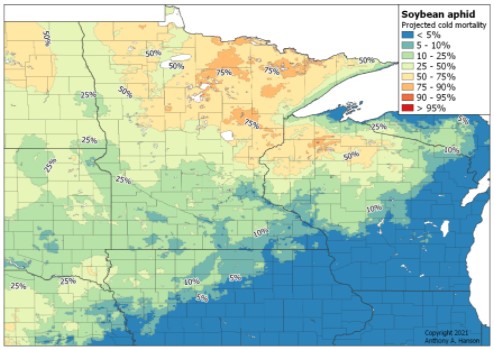For the most part, insects match the temperature of their surrounding environment, making them “cold-blooded.” Unlike warm-blooded animals, wind chill doesn’t really affect insects, but air temperature does. Even so, many insects can survive temperatures well-below freezing due to their own antifreeze compounds like glycerol.
Similar to weather forecasting, pest forecasting can give us a general idea of future insect populations. The minimum winter temperature (so far, around Feb. 15 this year) can help forecast freeze mortality (Fig. 2).

Figure 2. Predicted soybean aphid cold-exposure mortality on Feb. 15, 2021 based on average the freezing point of overwintering eggs at -29° F (std. dev.: 3.4) and minimum air temperature.
Where insects overwinter also affects mortality. Some insects, like corn rootworm, overwinter in leaf litter or soil, where they are protected from temperature extremes, especially when there is heavy snow cover. Most areas of Minnesota had between four to eight inches of snow cover during the coldest parts of this winter so far, so there would be some protection for these insects with both snow and soil cover.
Some invasive species, such as emerald ash borer that overwinter as larvae under tree bark, can begin to be affected by the cold temperatures we saw this February. However, their cold tolerance coupled with the temperature buffer of being inside a tree means many larvae can survive this winter intact, especially in southern Minnesota. Pests directly exposed to air temperature, like soybean aphid, would be most affected by the cold snap.
Soybean aphid
Because soybean aphid overwinters as eggs on buckthorn buds, there is little protection from cold exposure, unless they are under insulating snow cover. Eggs will freeze between -25 and -35 °F (McCornack et al. 2005), temperatures that were approached in parts of the state in early February. Some egg mortality can also occur above freezing, due to dehydration and late-fall cold snaps.
Outlook for 2021
Cold temperature mortality may be moderately high in parts of Minnesota (Fig. 2). In northern Minnesota, we may see near 50% egg mortality with a few areas experiencing near 75% mortality. In addition, the sustained low temperatures just above lethal temperatures can cause more mortality than what is projected on the map (e.g. multiple nights below -20 degrees F). However, this type of extended stress is much more difficult to use to predict pest risk than using the coldest night of the year as a ballpark. The February cold snap won’t eliminate soybean aphid from Minnesota, but it could reduce early-season populations in some areas.
Back in 2019, we also had a polar vortex that brought in even colder temperatures across the state, and projected mortality was also higher around 90% for much of northern Minnesota. The following growing season, soybean aphid was not much of a problem across the state, but they were still present in fields and did cause treatable levels of damage in a few areas.
Click here to see more...